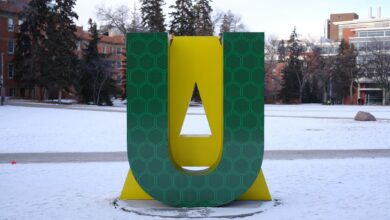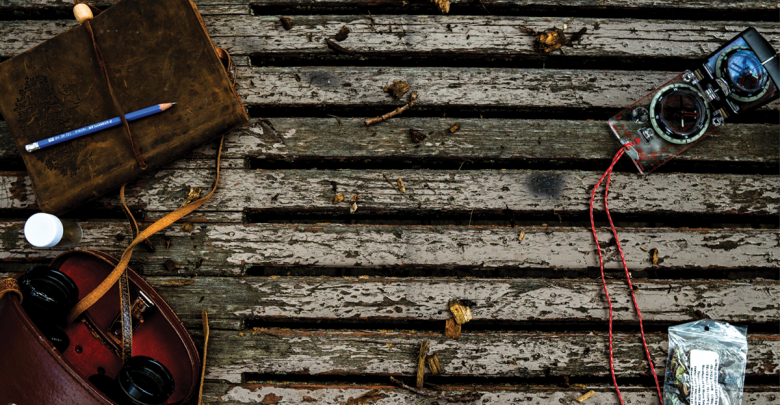 Richard Bagan
Richard BaganThis summer, my parents drove me to Portage College in Lac la Biche for field school, about two and a half hours north of Edmonton. The college sits on a hill leading down to the lake, which was still frozen over. The town’s major landmark is a water tower.
I was one of 60 students at field school this year. I’m taking environmental and conservation sciences, and the field school course is a requirement for our program, as well as forestry. We came out here to spend each day learning how to properly conduct field research and learn more about Alberta’s environment and natural resource industries.
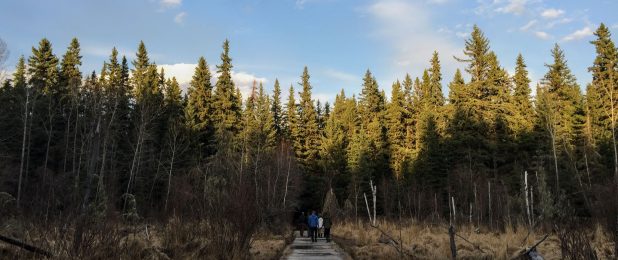
We were taught by professors, masters students, researchers, and industry professionals. Some taught us for a day, others for weeks. There was also our field school staff, who stayed with us the whole time.
I’d heard field school called Party 101, a month in the mud, and the three-week hangover — which now doesn’t surprise me. My classmates and I stayed up till 2 a.m. eating Kraft Dinner and playing beer pong as someone drunkenly sang along to a country song in the backyard.
I left field school sleep-deprived, sunburnt, and mosquito-bitten, but I learned a couple things while I was at it.
APRIL 30
We unloaded from the vans in our bright orange safety vests and helmets into what can honestly be described as the middle of nowhere. We were 40 minutes north of Lac La Biche on some plot of land owned by a forestry company. Our job was to track down about six randomly chosen tree plots in the woods that had been programmed into our GPS units.
My team of four double-checked that we had our satellite image of the area, map, measuring equipment, radio, compasses, and most importantly, the GPS.
We were wandering off on our own and none of us had any field experience, so when we realized our GPS units were set to an incorrect setting and all our predetermined locations were wrong, we were concerned. My team and I agreed that wandering confused through the woods and praying we didn’t run into any bears was pretty much what we expected from field school.
As we hiked, I was mystified by the speed at which the forest could transform from an open and sunlit aspen wood to dense black spruce. Even with our eyes closed, we could hear the transitions. [perfectpullquote align=”right” bordertop=”false” cite=”” link=”” color=”” class=”” size=””]One moment we’d be crunching through a meadow of reindeer lichen, and the next our feet would be muffled as they were swallowed up by moss thicker than a mattress.[/perfectpullquote]
We stumbled into a wetland where beams of sunlight fell through the sparse branches. The needles had fallen off the tamarack over the winter, and lumps of reddish-green sphagnum moss poked out like islands among still, reflective pools.
Colourful, tiny lichens and mosses blanketed the forest floor and trees. Short, leafy plants had already emerged from the frozen soil and were impossible not to step on. When I saw the hard hats and safety glasses on our list of required equipment for the day I thought that was overkill for a little walk in the woods. But, as it turns out, when you’re bushwacking, the bushes wack back.
What was particularly strange about this forest was that as isolated as we felt in one moment, the next we could stumble out of the woods back onto the highway as though we’d never been far from humans at all.
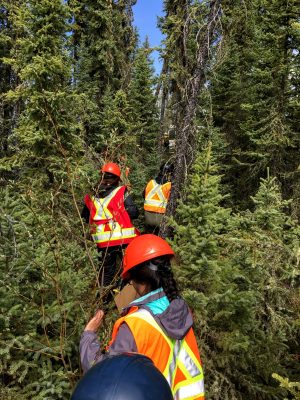
MAY 2, 2018
“This is a shovel,” Alex Drummond, our academic lead, said sarcastically as he demonstrated how to start digging our soil pit.
We were in Lakeland Provincial Recreation Area learning how to do ecosite classifications by examining the soil and vegetation of an area. But to get to know the soil we would have to do some digging.
The first soil pit we dug was on frozen ground. My team members got past the first layer of soil and once they were tired, I gave it a shot. After angrily attacking the ground for 20 minutes, I’d scarcely made the pit deeper. I decided that as badass as I felt wielding the giant axe over my head, the most damage I did with the tool was to my own wrists, which, as I write this, have me flinching in pain.
MAY 8, 2018
I’d always wanted to visit Fort McMurray. We were only there for two days, but we got to see the oil operations, something I’d never experienced.
The oil sands (or, more accurately, the bituminous sands) looked exactly as I expected: big, flat, and a cheerful grey. Without any trees or hills, dusty winds hit our faces when we stepped out of the vans on the side of the road — very Mad Max. Every once in a while I would jump at the explosive sounds coming from the air cannons surrounding each lake, designed to scare away any birds that dared to bathe in the toxic sludge.
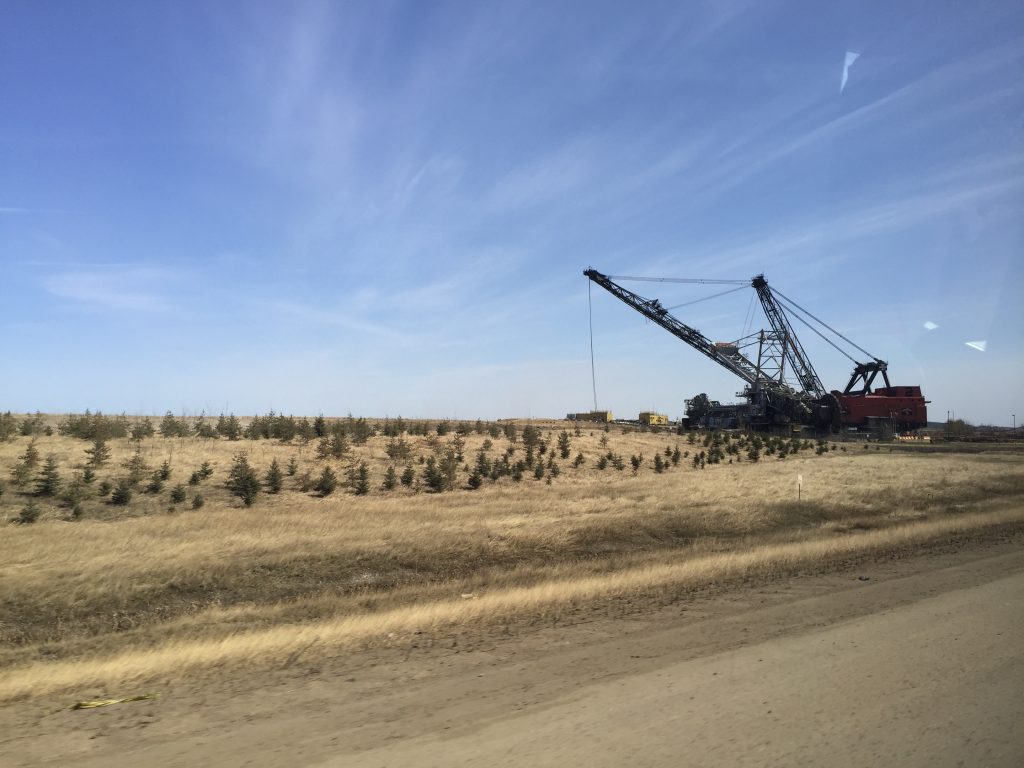
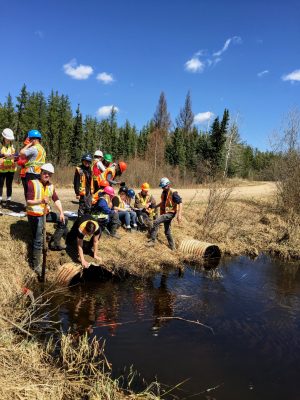
We visited a “reclaimed” hill on the edge of the sands to do some soil examinations. What we found was that although the hill appeared to be a self-sustaining forest, the soil told a different story. We speculated that should this hill have gone up in flames like the rest of this region had two years ago, that soil would have burned too because the top layer was made of peat moss. Without soil, no plant life would regrow.
To my surprise, I had no rude awakening when I saw the sands nor any life-changing revelations of my purpose as an environmental scientist. I suppose once you see a few photos of the oil sands you kind of get the idea.
MAY 10, 2018
Today, we explored the wetlands and I’ve never been so thankful for my rubber boots. In one bog, the ground sucked at my boots and lifted them off my feet. The air there is strangely crisp compared to the rest of the forest, and not much can grow beyond mosses and some hardier plants. The conditions are perfect to prevent decomposition. When our instructor pulled a sample from the ground, we were shown that soil a mere 1.5 metres below us was around 8,000 years old. The organic material had been alive briefly after the last ice age when mammoths roamed the region.
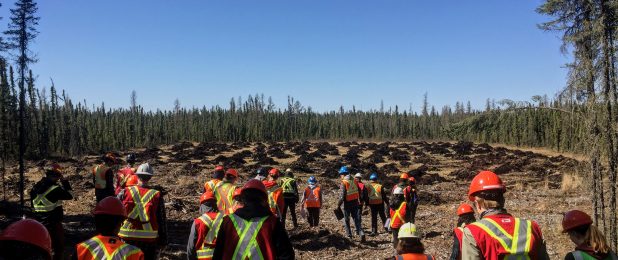
MAY 12, 2018
This trip, we’ve seen more wildlife than I could have ever imagined. Porcupines, bears, eagles, herons, kingfishers, beavers, woodpeckers, kestrels, cranes, pelicans, loons, and some of the neatest bugs. So a day specifically for wildlife was something I’d been looking forward to this whole time. We kicked off the day visiting Sir Winston Churchill Island Provincial Park on Lac la Biche. The place hasn’t burned in over 200 years, which makes the trees here far older than those in other regions of the boreal forest.
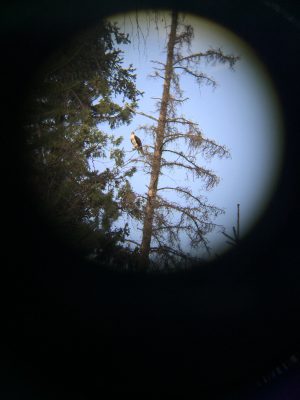
The island is a fantastic birding spot. Every couple minutes, I seemed to spot a woodpecker hopping up a tree trunk. Earlier we’d seen an osprey fly over us with claws full of long grasses for its nest.
We spent the second part of the day pond-dipping with nets in search of invertebrates. The sun was intense at this point in the afternoon, and hoards of tiny black insects buzzed above our heads. We tried to ignore all the spiders crawling over our backpacks, which we’d laid in the long grass around us as we dumped our nets into white pans filled with an inch of water, and sifted through the collection of wiggling creatures. Some students found water boatman, beautiful insects with dark green backs, large cartoonish eyes, and oar-like feet. [perfectpullquote align=”right” bordertop=”false” cite=”” link=”” color=”” class=”” size=””]We watched as some form of aquatic worm parasitized a water beetle and did our best to identify the nearly transparent insect nymphs.[/perfectpullquote]
We were handed butterfly nets for the next activity. Until this trip I’d never seen a grown adult go leaping and bounding after butterflies. It is an outrageously hilarious thing to watch and even better to do.
We ended the day back in town for a barbecue on the edge of Lac la Biche. With stomachs full of hamburgers, chips, and beer we went down to the beach and dipped our toes in the icy water. In between bouts of laughter and spaces in conversation we could hear the glassy echoes of ice floats bumping into each other as the lake thawed out. With the sunset painting the sky orange, we could see the water reflecting the warm tones of the sky where the ice made way for summer’s open lake.

